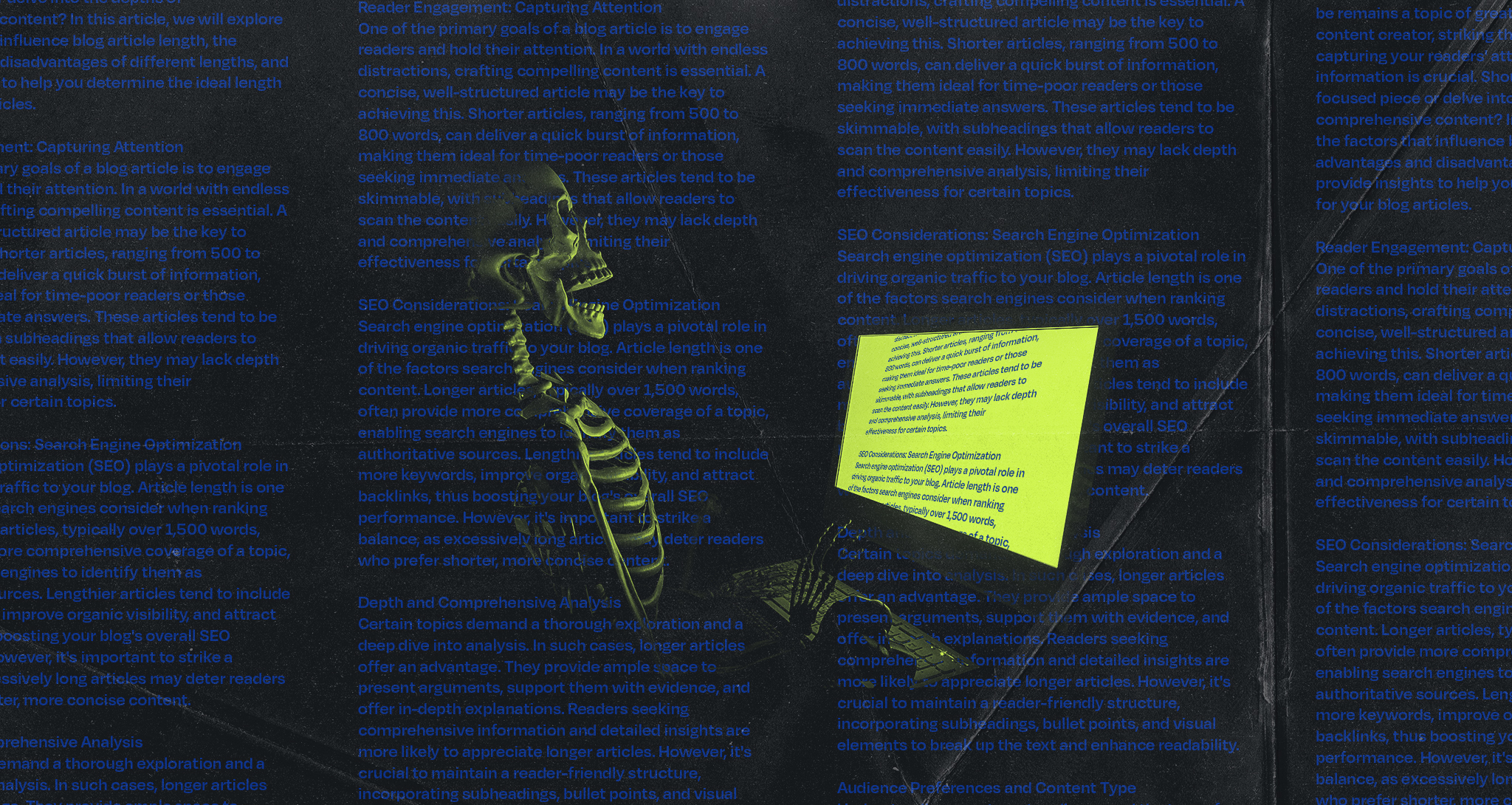Content creators often grapple with a pressing question: how long should a blog post be? While the answer may vary depending on several factors, a comprehensive study from SEMrush provides some valuable insights. According to their research, the sweet spot for blog post length, with respect to SEO performance, falls between 3,000+ words. But why does word count matter? And how does it impact your blog’s performance?
Before we get started: length is not as important as quality
Yes, length is a good measuring stick, but don’t favor length over quality (nobody like readying fluffed up articles). Ensure your content is digestible. Use subheadings, bullet points, images, and infographics to break the monotony of text, enhancing the overall reader experience.
If you can’t fill up the space without lowering the quality of your content – then don’t fill up the space.
The Importance of Word Count
Word count is a significant factor that influences your blog’s SEO performance, audience engagement, and shareability. It’s an integral part of your content strategy that can dictate your blog’s visibility in search engine results and its ability to retain reader interest.
From the perspective of SEO, long-form content tends to rank higher on search engine results. Posts that range 3,000+ words achieve superior SEO results, as they often provide more comprehensive coverage of the topic at hand. This expanded exploration increases the likelihood of including a variety of keywords and related phrases.
Furthermore, search engines, like Google, perceive in-depth content as high-quality information, improving your chances of achieving higher rankings. The added length also accommodates more opportunities for internal and external linking, strengthening your SEO efforts.

Not all blogs need to be 3,000 words
Yes, Google loves long-form content (because it tends to be keyword rich), but Google also loathes bad shallow, non-helpful content. That means you are better off to write quality than you are to write quantity. Writing quality means that your articles may not hit 3,000 words – and the truth is, different types of articles tend to fall within different patterns of lengths.
That makes sense though, doesn’t it? For example, you wouldn’t expect a news article about a local event to be the same length an article that covers a comprehensive approach to a broad subject matter.
So, let’s break it down by article type.
Common blog lengths, by type
Okay, first a disclaimer. There are no magic rules for blog length that makes Google say “oh, I am going to rank you higher”. That said, considering an article’s length is valuable because you can use it as a rough way to measure if you have explored your topic deep enough, or if perhaps you should go a little further.
When we are writing our own articles, here are some rules of thumb we use to dummycheck ourselves, depending on the type of article we are writing. Usually we’ll try and stay in these ranges, if it makes sense in the context of the subject matter.
Pillar pages: 2,000 – 3,000 words
Pillar pages are the authoritative articles on your website, which means they need to provide the most in-depth content on the subject they describe. This generally means that the content will attempt to cover all aspects of the subject matter, and link to sub-articles which will cover specific aspects in more detail. As with the rest of the article types, don’t just “fill up space” with words, but a good rule of thumb for pillar pages is that they should have a targeted length of somewhere between 2,000 and 3,000 words.
Guides and how-tos: 1,000 – 1,600 words
The length of how-to guides or instructional blog posts can vary widely based on the complexity of the topic, the depth of the instruction, and the target audience. However, according to multiple SEO and content marketing sources like HubSpot, a good ballpark figure to aim for is around 1,600 words or roughly 7 minutes of reading time. This length allows for comprehensive coverage of a topic without being too lengthy or intimidating for readers.
News Articles: 800 – 1,000 words
The ideal length of a news article varies based on the complexity of the story, the medium, and the target audience, among other factors. However, as a general rule of thumb, online news articles often range between 800 and 1000 words, and most news sources try and limit their length to 1,500 words. This range allows the journalist to present a comprehensive overview of the news event, incorporating all essential details and providing context, while still maintaining the reader’s interest.
Press releases: 400 – 700 words
In terms of industry best practices, press releases are generally advised to be succinct and direct, typically ranging from 400 to 700 words. According to The Guardian, this is considered an optimal length to relay all critical information without being excessively verbose or too scant on details. It’s key to focus on the most important information and present it in a clear, compelling manner. Press releases longer than this range risk losing the reader’s attention, while shorter ones may lack necessary details.
How to build this knowledge into your writing workflow
It’s not always each to keep article length in mind, especially while you are trying to provide quality content, research keywords, source cool images, etc. Here’s how we do it at Wonderful (hint: you’ll notice we don’t worry about length until the end).
1. Identify the goal of your article
Always know your destination. This will help you understand the type of article you are intending to write. Is it a pillar page? Is it a simple news article? Not only will this be helpful when targeting a length, but it will make sure you are crafting your content to match your intention.
2. Research keywords and content
Before writing anything, you need to know how you are going to approach it. This means using a tool like SEMRush to research keywords that are related to your subject matter (so that you can form content around them), and obviously, researching the subject matter itself. Usually you’ll know whether you actually have a good article idea by the end of this step.
3. Outline your approach
Jot down the general structure of your article, including all the main headlines you want to cover. Headlines are “landmarks” that readers will have as they explore your article. Plan a journey across the subject matter that will keep them interested and engaged.
4. Just write an awesome article and forget the length
As we said earlier, quality trumps everything. Don’t start with a target length and just race to the finish line – in fact, don’t even think about length. Instead, write something you are proud of and that you think someone could read and pull value from.
5. Finally, check your article’s SEO quality and add length if required
Now that you’ve written an awesome article, use an SEO tool like SEMRush or Yoast to check the quality of the content against common SEO rules. Often times, you’ll need to adjust for keyword density, add links, and more.
In this step, you may find you have fallen short of a good length. If you have, go back to your content and see if there is any further value you can add. If there is, then great! If there isn’t: STOP. Resist the urge to spam your own content (you won’t fool anybody – especially Google).
Did you see how we approach length, here at Wonderful? We definitely care about it, but we don’t force it. Value always wins.
So, how long should a blog post be?
Well, it depends on the type of blog post you are writing, and your ability to fill the page with quality content.
At Wonderful, we write a lot of content, and we find that different blog types tend to have standard lengths (if we are writing them properly). What does writing them properly mean? It means covering the subject matter extensively, providing value to the reader, and supplying all keywords and content that help with search rankings. What does it not mean? It does not mean filling up the page until we hit a word count.




